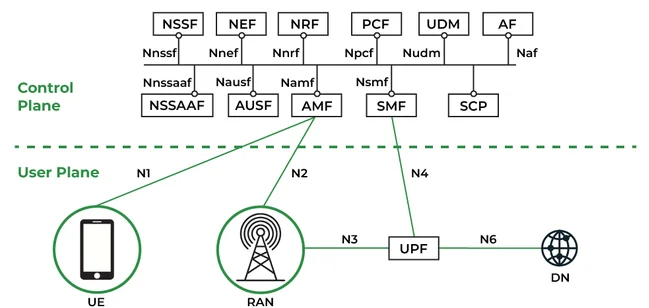Introduction:
The emergence of 5G technology in the telecommunications industry brings about an enormous improvement in connectivity instead of ordinary. A new type of network is coming up that will provide superfast speed, less latency, and loads of connection gadgets to be supported. Yet, below the apparent smooth process lies the complex simulation of the system that is responsible for the smooth journey of the data throughout the network. Here, we’ll dive into 5G network blueprint element wise uncovering architecture layer after layer.
1. Evolution from 4G to 5G:
To avoid misunderstanding, let’s clarify in advance what 5G architecture is and how it differs from older generations. In contrast to 4G LTE which 5G introduces important additions, 5G goes on from 4G, LTE that makes it better in many ways.
Unlike the first one, the feature of this new generation was either higher data rates, low latency, higher capacity from many devices connections at a time, and facilitated the new ways of usage; Internet of things (IoT), augmented reality (AR) and virtual reality (VR).
2. Core Components of 5G Network Architecture:

Radio Access Network (RAN): 5G is structured around the RAN, the segment connecting devices such as smartphones and Internet-of-Things sensors. Following the RAN is the core network, where all network activities take place. Unlike traditional technologies, the fifth generation RAN incorporates advanced methods like mass MIMO and beamforming. These techniques aim to boost spectral efficiency and improve network coverage. By leveraging modern innovations, 5G enhances connectivity and performance for a wide range of applications.
Core Network: The main network which acts as the baseline of 5G is responsible for functioning purposes such as billing, authentication and mobility management. It has been devised to be more elastic and adaptable with alignments toward cloud-based services and virtualization for application to the diverse services and programs.
Edge Computing: Being a core part of the 5G standard, this gives edge computation and data storage much closer proximity to the end users. This contributes to latency reduction and leads to instant responsiveness. With the ability to process compute resources where the network reaches, 5G can handle critical low-latency apps. Such applications include autonomous vehicles or distance surgery. The proximity of edge computing and data storage to end users is a key advantage of 5G technology.
Network Slicing:The most remarkable characteristic about 5G architecture is isolation networking. Isolation networking brings about the creation of multiple virtual networks over a single physical network. Every bite is designed to meet specific applications’ performance requirements. Therefore, operators will be able to diversify their customer base by catering to different groups and drawing for diverse demand in bandwidth, latency and reliability.
3. Architecture Layers:
Physical Layer: In the lowest level, it is physical layer, which consists of hardware signals that are employed for transmitting and receiving radio signals. To mention of few, a transceiver, amplifiers, antennas and signal processing modules are among the components.
MAC (Medium Access Control) Layer: The layer MAC provides coordination for access provisions to a wireless medium. It also cope with data frames transmission procedures between devices and the base station.
Network Layer: MAC layer is interposed on top of it the network layer that manages the routing of packets and their forwarding among the network. It covers the Operation such as IP (Internet Protocol) and ICMP (Internet Control Message Protocol)
Application Layer: Comprising the highest elevation of the 5G architecture stack is the application layer and this is where the software applications located that squeeze the internetwork to offer services to the end-users. This includes browser internet, the applications of streaming media, and the platform of IoT.
4. Key Technologies Driving 5G Network Architecture:
Millimeter Wave (mmWave): Offering the service across the entire millimeter wave band, 5G network is capable of delivering multigigabits per second rates. On the other hand, mmWave signals are very sensitive to their reduced coverage and consequently must be distributed manually via small cells.
Massive MIMO: As the name suggests, MIMO technology in a massively scale uses many antennas at the base station to provide the multiple users with a service simultaneously, so, it ends up increasing the spectral efficiency and network capacity.
Network Function Virtualization (NFV): NFV’s main function is to bring along the virtualization of functions. These functions were originally provided by dedicated hardware appliances. By using NFV, networks can achieve greater capacity and scalability.
Software-Defined Networking (SDN): SDN is a network model that disconnects control plane from data plane eventually leading to centralized logical control over network infrastructure. This will allow network operators to increase the network responsiveness functions and therefore allow them to offer the services faster.
Read Also: 5 Major Micron’s Role in AI and Machine Learning-Mobiles specs
Conclusion:
5G architecture resembles an operating system. It consists of multilayered distributed components that perform different functions. These components together provide high-speed and low-latency connectivity to users. 5G introduces advancements such as Massive MIMO, Edge computing, and network slicing. These technologies are reshaping various industries and altering communication dynamics. They are revolutionizing how we connect, interact, and engage with our surroundings.The deployment of 5G is progressing rapidly worldwide. This pace necessitates telecom industry participants to grasp its architecture thoroughly. Understanding 5G’s architecture is crucial in this evolving landscape.
As we navigate the evolving landscape of technology, it’s essential to approach the deployment of 5G with foresight and responsibility. This ensures that it serves the collective good while fostering innovation and inclusivity. By doing so, we can harness the full power of 5G to propel society forward into a more connected and dynamic future.

